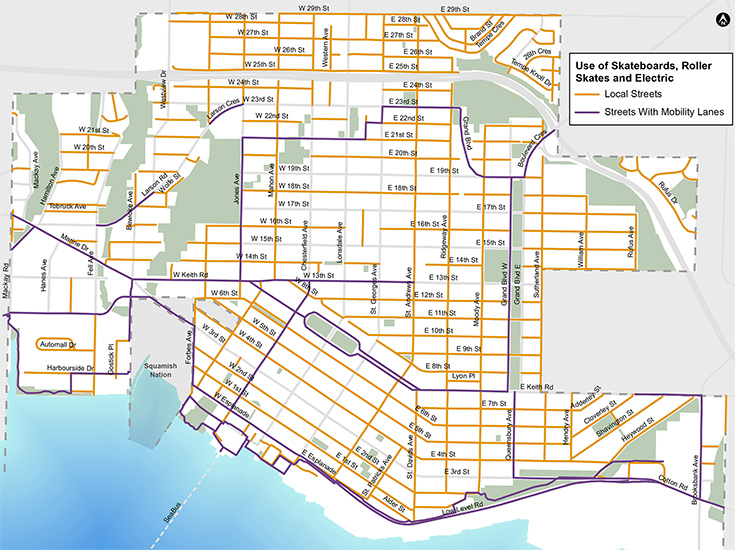During the pilot, e-scooters can be used on:
- Local streets (i.e. without continuous centreline)
- Mobility lanes (i.e. which accommodate a range of micro-mobility options like bicycles, scooters, e-bikes, and cargo bikes)
- Paved multi-use pathways (e.g. Spirit Trail, Green Necklace)
E-scooters may not be used on sidewalks, major streets (i.e., arterial and collector roads with a continuous centreline), or unpaved park trails. Permitted areas are shown on the map below.
DID YOU KNOW? Mobility lanes are dedicated areas on streets and pathways that accommodate a range of micro-mobility options like bicycles, scooters, e-bikes, and cargo bikes. Mobility lanes are separated from motor vehicle traffic by a demarcated buffer such as paint, curbs, planters, bollards, or other similar measures.

> Download PDF of map
In BC, e-scooter riders must be at least 16 years of age and wear a helmet while riding. There is no driver’s license requirement to operate an e-scooter. In addition, e-scooter riders must:
- Slow down when riding near pedestrians on multi-use pathways
- Use a bell or horn when passing other riders or pedestrians
- Ride single-file
- Not tow or carry another person
- Adhere to local regulations about where e-scooters can be ridden, as in Where Can E-Scooters Go In the City, above
E-Scooters are subject to the following Provincial requirements in BC:
- The device must have a maximum speed of 24 km/h
- Motor power output must not exceed 500W
- Must be equipped with an adequate braking system
- Must have a bell or horn
- Lights are required between sunset and sunrise
- Device must not be equipped with a seat, pedals, or structure enclosing it
E-scooter bylaws and regulations carry fines under the Motor Vehicle Act, and are enforceable by the RCMP.
E-scooters are electrically powered kick scooters that are suited to short urban trips. They have a standing platform between the front and rear wheels, and a steering handlebar that acts directly on the front wheel(s) of the device. E-scooters in BC may have two to four wheels.
The full legal definition of an e-scooter and additional information can be found on the Province’s pilot project webpage.